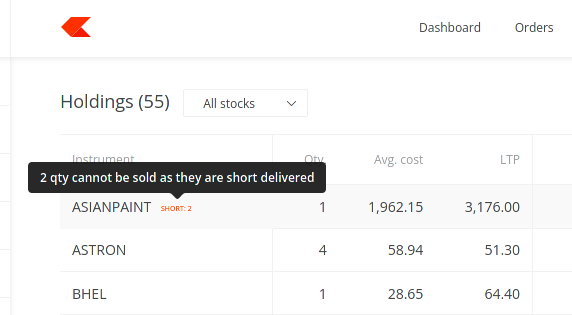What is short delivery and what are its consequences?
When the seller of a stock fails to deliver the shares to the exchange for the buyer's demat account, it is known as short delivery. This generally occurs when intraday short positions cannot be closed because of illiquidity or stocks hitting the upper circuit. To learn more about circuit limits, see What are circuit limits or price bands?
The consequences of short delivery are different for the buyer and the seller and are as follows:
Buyer
How to know if the shares have been short-delivered?
Buyers are notified through email and a Kite notification when a short delivery happens. A short-delivery tag is also displayed beside the short-delivered stock.
Kite app
The short-delivered quantity is displayed for the stock.

Kite web
Hovering over the tag displays the short-delivered quantity.

When will the shares be credited after a short delivery?
The shares will be credited to the buyer’s demat account on T+2 day after the exchange holds an auction on T+1 day to procure the short-delivered shares. If the exchange cannot procure the shares in the auction, the Zerodha account will be credited with cash based on the close-out price. See, When does cash settlement happen to close out short delivery?
Example Scenario
- Shares are purchased on Monday (T day) and are tagged as T1 holdings until Tuesday (T+1 day).
- If the shares were not delivered on Tuesday (T+1 day), a short delivery tag is applied to the stock on Wednesday (T+2 day).
- The exchange delivers the shares procured from the auction market held on Tuesday (T+1 day) and delivers them on Wednesday (T+2 day). The shares will be visible on Kite from Thursday (T+3 day).
Seller
What happens when the seller defaults?
The exchange conducts an auction to deliver the short quantities from other sellers. For shares sold on Monday, the auction happens on Tuesday, with the closing price of Monday used to determine the auction price. The price range of the auction is capped at 20% at the upper and lower end. For this reason, an additional 20 % is blocked in the seller's Zerodha account until auction settlement.
The exchange delivers the shares to the buyer’s demat at the auction price on Wednesday, and the defaulting seller is sent an auction note and is obligated to pay an auction penalty to the exchange.
Example scenario
- 100 shares are sold on Monday (T day) at ₹800 per share. The stock hits the upper circuit, and there are no sellers.
- The exchange conducts an auction on Tuesday (T+1 day) and uses the closing price of Monday (T day) to determine the auction price. If the closing price were ₹830, the auction price range would be ₹664 to ₹996, i.e. 20% upper and lower of the closing price.
- If the auction price were ₹920, on Wednesday (T+2 day) the seller would have to pay ₹12,000 [(₹920 - ₹800)*100].
Did you know? If the auction price is lesser than the closing price on T day, the higher price is used to calculate the auction penalty, and the difference between the auction price and the closing price is transferred to the investor protection fund.
Still need help?


